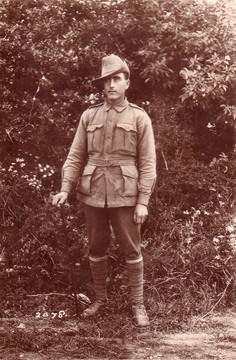
83415
GRAY, Charles Stewart
| Service Number: | 4181 |
|---|---|
| Enlisted: | Not yet discovered |
| Last Rank: | Lance Corporal |
| Last Unit: | 10th Infantry Battalion |
| Born: | Not yet discovered |
| Home Town: | Not yet discovered |
| Schooling: | Not yet discovered |
| Occupation: | Not yet discovered |
| Memorials: | Kalangadoo Public School Pictorial Honour Roll, Penola District WW1 Roll of Honor |
World War 1 Service
| 11 Jan 1916: | Involvement Private, 4181, 10th Infantry Battalion, --- :embarkation_roll: roll_number: '10' embarkation_place: Adelaide embarkation_ship: HMAT Borda embarkation_ship_number: A30 public_note: '' | |
|---|---|---|
| 11 Jan 1916: | Embarked Private, 4181, 10th Infantry Battalion, HMAT Borda, Adelaide | |
| 11 Nov 1918: | Involvement Lance Corporal, 4181, 10th Infantry Battalion |
Lance Corporal Gray
Charles Stuart Gray was born in Kalangadoo, South Australia on 21st April 1893. He was one of nine children of William Stuart and Sarah Jane Gray. His siblings were Elizabeth, Mabel, Jessie, Eva, Ethel, Annie, Myrtle and William. The family lived in a little four roomed cottage at the back of the Methodist Manse.
Charles attended Kalangadoo School from 1900 to 1907.
After schooling he worked as a labourer on various farms before the war.
Private Gray enlisted on the 17th August 1915, along with three other local Kalangadoo lads, one being Percy Ellison who was K.I.A.
He trained at Mitcham Camp in Adelaide with the 13th reinforcements for the 10th Battalion, before embarking on the troopship Borda on the 11th January 1916.
On arrival in Egypt the 10th Battalion was split and as a result Private Gray was transferred at the end of February 1916 into the newly formed 50th Battalion.
After training in Egypt, the Battalion was sent to France, however Private Gray was admitted to Hospital at Rollestone, England with Pneumonia before rejoining his unit in August 1916.
The unit took part in a second assault launched at Mouquet Farm on the 3rd September 1916. The battalion saw out the rest of the year alternating between front-line duty and training and labouring behind the line. This routine continued through the bleak winter of 1916-1917.
Early in 1917, the battalion participated in the advance that followed the German retreat to the Hindenburg Line. Later that year, the battalion was involved in the battle of Messines and the battle of Polygon Wood. Another winter of trench routine followed. In August 1917 Private Gray was promoted to Lance Corporal.
In April 1918, the 50th Battalion assisted in the repulse of the largest German attack mounted against Australian troops during the war. The German threat persisted through April, and on Anzac Day 1918 the 50th participated in the now legendary attack to dislodge the enemy from Villers Bretonneux.
The 50th Battalion continued to play an active role during the Allies’ own Offensive. It’s last major operation of the war was the attack on the Hindenburg outpost line”.
Lance Corporal Gray returned to Australia on board Armagh disembarking on the 16th May 1919.
Lance Corporal Gray was awarded the following medals
1914/1915 Star
British War Medal
Victory Medal
On returning to Kalangadoo after WW1 Charles planted Pine Trees for contract at Nangwarry and Tarpeena, riding his bike to and fro each day. He did fencing contracts for many of the big properties. He was very proud of his fences but many were destroyed by Ash Wednesday. Charles then became a potato farmer on leased land which was all done by horses and dug by hand in those days and supplemented his income by trapping rabbits and selling the meat and fur.
Charles and Vera (nee Schmidt) were married on 15th February 1922 and made their home in Kalangadoo. Charles was allocated a soldier settlers block (373, Swigg’s old house) where they originally lived. before building a home in the township in the 1930’s on George Street. Charles and Vera welcomed their first child, Nancy in 1922. Following this they had 3 more children, Lawrence in 1926, Charles (aka Bruce) in 1927 and Margaret in 1932.
He was a life member of the Kalangadoo Ex-Servicemen’s Club and a member of the RSL. He was also awarded life membership of the Kalangadoo Football Club in recognition of his time as a player and later a supporter of the club. Charles was also a very good shot and during the 1930’s he was a member of the Kalangadoo Gun Club, reportedly winning many trophies.
Sadly Vera passed away in 1960 at the age of 56. Charles retired from potato farming in 1962 and continued to live in Kalangadoo until his passing on 26th May 1973, aged 80. He is buried at the Lake Terrace Cemetery in Mount Gambier.
A Brave Soldier at Rest
Lest We Forget
Submitted 22 April 2025 by Peter Savage









